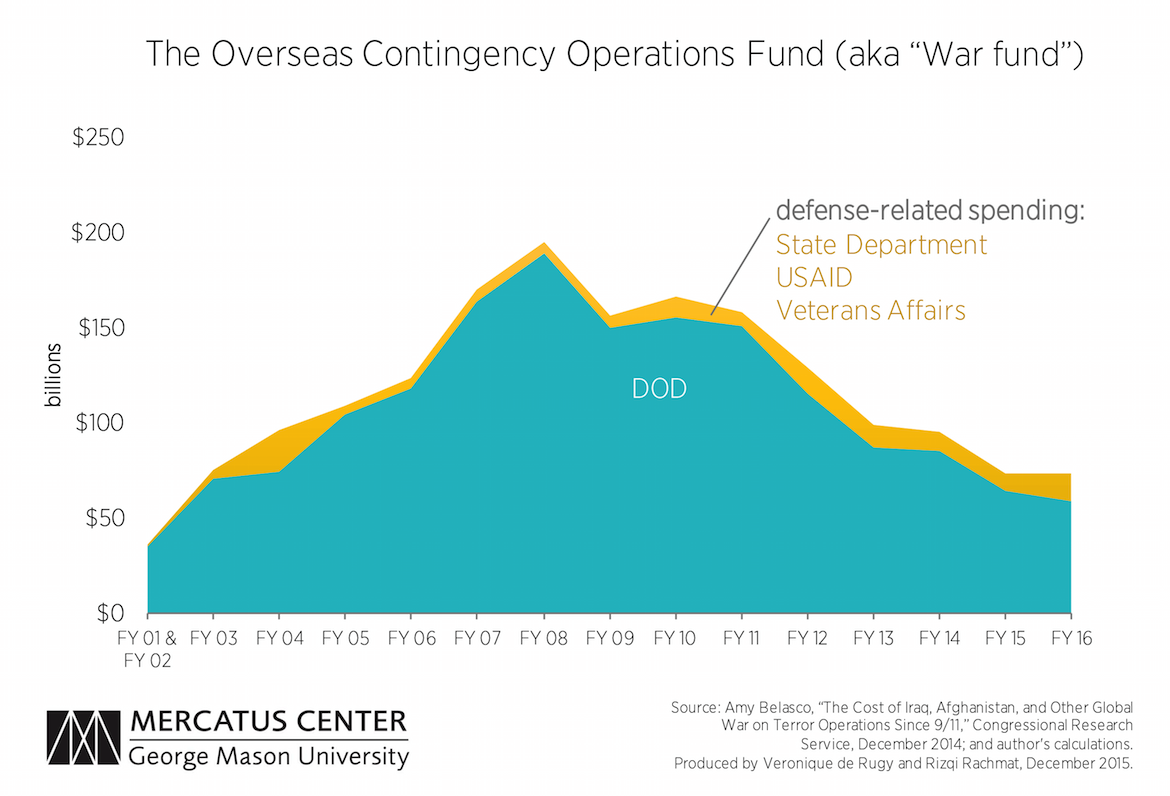- | Government Spending Government Spending
- | Data Visualizations Data Visualizations
- |
“War Fund” Is a Budget Gimmick
This week’s chart looks at total OCO funding from fiscal year (FY) 2001 to projected FY 2016, which amounts to a cumulative $1.75 trillion. Of that amount, 92 percent has gone to the Pentagon and the rest went to the State Department, US Agency for International Development, and the Department of Veterans Affairs.

Earlier this year I looked at total inflation-adjusted funding for the Department of Defense (DOD) going back to 1948. When a separate account for post-9/11 war funding is included, the Pentagon’s budget is still slightly above its Cold War peak despite dropping following the military drawdown in Afghanistan and Iraq. Policymakers have been able to keep DOD funding elevated thanks to the so-called “war fund,” which is exempt from the caps on defense funding that were put in place by the Budget Control Act of 2011. The war fund, formally known as the Overseas Contingency Operations (OCO) fund, has been derided by critics who have labeled it a “budget gimmick” and a “slush fund” for the Pentagon.
In the recent bipartisan budget agreement that I previously discussed, policymakers busted existing spending caps by allowing for an additional $80 billion in funding over the next two years. This funding will be split evenly between defense and nondefense accounts. As expected, that boost in regular DOD funding allowed for a lower level of OCO funding for the Pentagon than what policymakers had originally pushed for. However, OCO funding for non-Pentagon uses—the State Department and related foreign aid—saw a substantial boost.
This week’s chart looks at total OCO funding from fiscal year (FY) 2001 to projected FY 2016, which amounts to a cumulative $1.75 trillion. Of that amount, 92 percent has gone to the Pentagon and the rest went to the State Department, US Agency for International Development, and the Department of Veterans Affairs.
The tail end of the chart shows the increase in the amount for non-Pentagon funding, which will be almost $15 billion in FY 2016. That’s a sizable increase above the average of around $9 billion for non-Pentagon uses since FY 2001. Appropriators don’t need to put as much funding into the regular budgets for the State Department and related activities because of the additional non-Pentagon funding in the OCO. That would then free up space for appropriators to increase funding for a plethora of nondefense programs, and that funding would itself come on top of the extra funding made available by busting the budget caps.
Policymakers should have been looking to completely eliminate the OCO gimmick. Instead, they took what has been a slush fund for the Pentagon and extended it further into nondefense funding. Such gimmicks and budgetary sleight-of-hand are another example of Washington’s general disregard for fiscal responsibility and disrespect for taxpayers.




